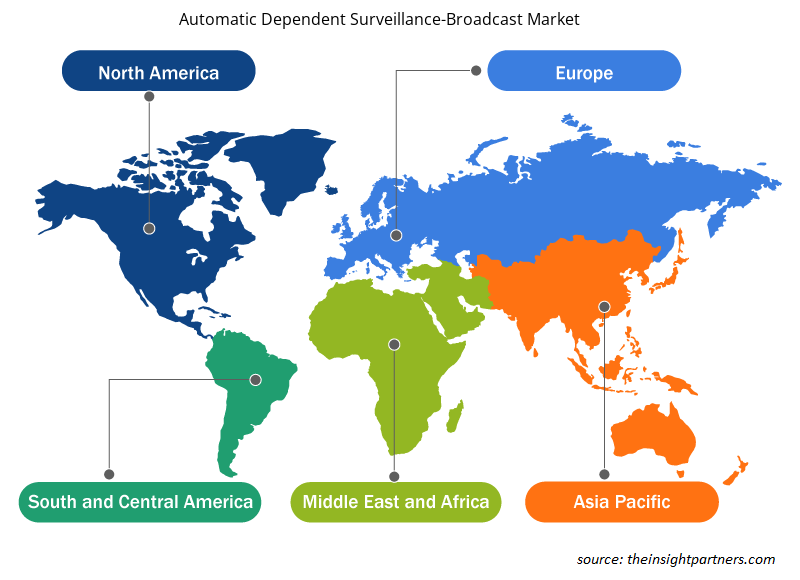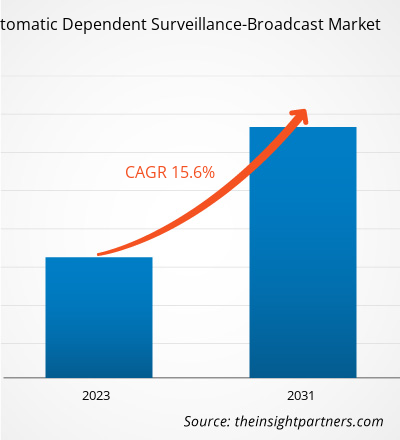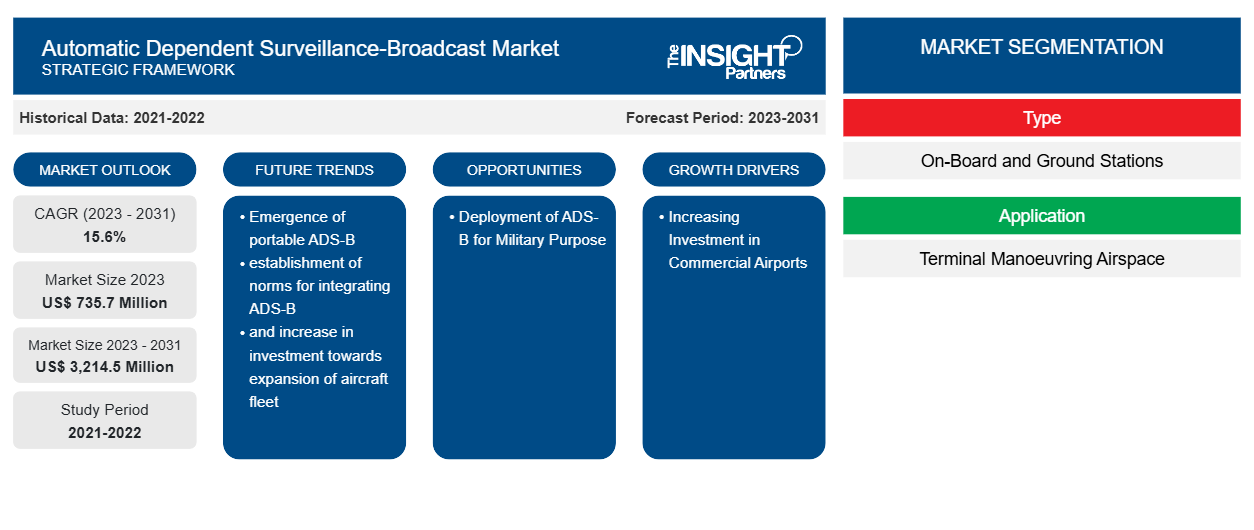من المتوقع أن يصل حجم سوق المراقبة والبث التلقائي المعتمد إلى 3214.5 مليون دولار أمريكي بحلول عام 2031 من 735.7 مليون دولار أمريكي في عام 2023. ومن المتوقع أن يسجل السوق معدل نمو سنوي مركب بنسبة 15.6٪ في الفترة 2023-2031. يعد ظهور ADS-B المحمول، وإنشاء معايير لدمج ADS-B، وزيادة الاستثمار نحو توسيع أسطول الطائرات من بين الاتجاهات الرئيسية التي تقود سوق المراقبة والبث التلقائي المعتمد.
تحليل سوق المراقبة التلقائية التابعة للبث
إن العدد المتزايد من طلبات وتسليمات أساطيل الطائرات في جميع أنحاء العالم، إلى جانب تفويضات استخدام ADS-B، يلعب دورًا إيجابيًا في تعزيز اعتماد ADS-B. كما من المتوقع أن يؤدي زيادة الاستثمار في ترقية المطارات التجارية بمرافق وتقنيات متقدمة إلى تعزيز اعتماد ADS-B. بالإضافة إلى ذلك، من المتوقع أن توفر المشاريع التي وافقت عليها سلطات الطيران في دول مثل الولايات المتحدة لاستخدام ADS-B في التطبيقات العسكرية فرص نمو واسعة لمصنعي ADS-B خلال فترة التنبؤ. كما من المتوقع أن يساهم ظهور ADS-B المحمول لتوفير تكلفة تصنيع وتثبيت ADS-B القياسي في نمو السوق.
نظرة عامة على سوق المراقبة التابعة التلقائية - البث
ADS-B هي تقنية مراقبة لا تتطلب أي حافز خارجي. تعتمد هذه التقنية على مركبات المطار والطائرات لبث موقعها وهويتها وغيرها من المعلومات التي تم الحصول عليها من أنظمة على متن الطائرة مثل GNSS. يتميز ADS-B بميزات تشمل الأداء العالي والاستدامة البيئية والتوافق العالمي والقدرة المتزايدة والسلامة المحسنة. بالإضافة إلى ذلك، فإن البنية التحتية لمراقبة ADS-B أقل تكلفة من تقنية الرادار الأساسية ، مما يجعلها فعالة من حيث التكلفة لأغراض المراقبة. من المتوقع أن يؤدي ارتفاع الاستثمار نحو توسيع أساطيل الطائرات في جميع أنحاء العالم إلى دفع نمو سوق المراقبة التابعة التلقائية خلال فترة التنبؤ. بالإضافة إلى ذلك، من المتوقع أن يزداد الطيران التجاري في السنوات القادمة بسبب العدد المتزايد من المسافرين جواً وشراء طائرات جديدة. في أمريكا الشمالية وأوروبا ومنطقة آسيا والمحيط الهادئ، كانت حركة الركاب الجويين تتزايد بمرور الوقت، مما يغذي الطلب على الطائرات التجارية. في منطقة آسيا والمحيط الهادئ، وخاصة في الصين والهند، ثبت أن الطائرات التجارية للسفر المحلي فعالة من حيث التكلفة. ومن المتوقع أن يؤدي هذا إلى تغذية نمو السوق في السنوات القادمة.
قم بتخصيص هذا التقرير ليناسب متطلباتك
ستحصل على تخصيص لأي تقرير - مجانًا - بما في ذلك أجزاء من هذا التقرير، أو تحليل على مستوى الدولة، وحزمة بيانات Excel، بالإضافة إلى الاستفادة من العروض والخصومات الرائعة للشركات الناشئة والجامعات
-
احصل على أهم اتجاهات السوق الرئيسية لهذا التقرير.ستتضمن هذه العينة المجانية تحليلاً للبيانات، بدءًا من اتجاهات السوق وحتى التقديرات والتوقعات.
محركات وفرص سوق المراقبة التابعة التلقائية للبث
زيادة الاستثمار في المطارات التجارية
مع زيادة عدد المطارات التجارية في جميع أنحاء العالم، يتزايد أيضًا اعتماد نظام ADS-B. يتم تنفيذ هذه التكنولوجيا حاليًا في مناطق مثل أوروبا وأمريكا الشمالية وآسيا. مع زيادة البنية التحتية للمطارات التجارية أو تجديد المطارات الحالية، يتزايد أيضًا عدد المعدات الأرضية، مثل محطات مراقبة الحركة الجوية، وبالتالي الاستفادة من نظام ADS-B لتتبع الطائرات. في دول مثل الصين، يعد مطار تشونغتشينغ جيانغبي الدولي (CQIA) من بين أكبر 10 مطارات، والذي يخضع لخطة توسع كبيرة. من خلال الاستثمار، من المقرر أن يحصل المطار على وضع المحور الجوي الدولي وسيكون الأكبر في غرب الصين بحلول عام 2035. مطار آخر في الصين يشهد استثمارًا لتطوير مطار هو مطار بكين داشينغ الدولي.
وقعت شركة مطارات جنوب شرق ليتوانيا اتفاقية قرض بقيمة 81 مليون دولار أمريكي (70 مليون يورو) مع بنك الاستثمار الشمالي لتحديث المطارات الثلاثة الرئيسية في ليتوانيا: فيلنيوس وكاوناس وبالانغا. ومن المتوقع أن تعمل مثل هذه المشاريع المتعلقة بتحديث المطارات على دفع تبني التقنيات المتقدمة، بما في ذلك ADS-B. وتمثل البيانات التالية الاستثمارات من حيث بناء/ترقية/تحديث المطارات في مناطق مثل أمريكا الشمالية التي ستشهد 20 مليار دولار أمريكي، ومنطقة آسيا والمحيط الهادئ التي ستشهد 90.86 مليار دولار أمريكي، ومنطقة جنوب شرق آسيا ستشهد 1.12 مليار دولار أمريكي، ومنطقة الشرق الأوسط وأفريقيا 42.92 مليار دولار أمريكي لتطوير مطاراتها.
ومن المتوقع أن تؤدي الاستثمارات المذكورة لبناء مطارات جديدة وتحديث المطارات القائمة إلى زيادة نشر تقنيات المراقبة المتقدمة لتتبع الطائرات بشكل أفضل . وبالتالي، فإنها تساهم بشكل إيجابي في نشر نظام البث التلقائي المستقل، الذي يقود سوق البث التلقائي المستقل.
نشر نظام ADS-B لأغراض عسكرية
يتوسع نطاق ADS-B لضمان التتبع الدقيق للطائرات. مع التقدم التكنولوجي المستمر، يتزايد تكامل ADS-B بين الطائرات العسكرية. وفقًا للقوات الجوية الأمريكية، من المتوقع أن يمتلك البنتاغون 2936 طائرة مجهزة بنظام ADS-B Out بتوجيه من تفويض إدارة الطيران الفيدرالية. بحلول عام 2025، تهدف وزارة الدفاع الأمريكية إلى تجهيز ما يقرب من 62٪ من طائراتها بنظام ADS-B (Out)، بما في ذلك أكثر من 67٪ من المروحيات، و35٪ من الطائرات المقاتلة، و100٪ من طائرات التنقل والتدريب والقيادة والتحكم / الاستخبارات والمراقبة والاستطلاع (C2 / ISR). ومن المتوقع أن يتم تجهيز ما يقرب من 1129 طائرة هليكوبتر، و259 طائرة C2 / ISR، و923 طائرة تنقل، و625 طائرة تدريب بنظام ADS-B وفقًا للقوات الجوية. في وزارة الدفاع، من المتوقع أن تشمل الطائرات التي من المتوقع أن تتلقى نظام ADS-B Out طائرات بوينج C-17 Globemasters، وطائرات الهليكوبتر Lockheed Martin UH-60 Black Hawk، وطائرات النقل C-130 وC-5. ومن المتوقع أن يؤثر هذا الانتشار الهائل لنظام ADS-B في الطيران العسكري على نمو سوق البث الإذاعي التلقائي المعتمد بشكل فعال.
تقرير تحليل تجزئة سوق المراقبة التابعة التلقائية للبث
إن القطاعات الرئيسية التي ساهمت في استخلاص تحليل سوق المراقبة المعتمدة على البث التلقائي هي النوع والمستخدم النهائي.
- بناءً على النوع، تم تقسيم سوق البث الإذاعي التلقائي المعتمد إلى محطات على متن الطائرة ومحطات أرضية. احتل قطاع المحطات على متن الطائرة حصة سوقية أكبر في عام 2023.
- بناءً على التطبيق، تم تقسيم سوق المراقبة والبث التلقائي إلى مراقبة المجال الجوي للمناورة الطرفية (TMA) والمراقبة المحمولة جواً. احتل قطاع المراقبة المحمولة جواً حصة سوقية أكبر في عام 2023.
- على أساس المكونات، تم تقسيم السوق إلى هوائيات وأجهزة استقبال ومستقبلات مرسلة ومستقبلات أرضية AD-B. هيمنت شريحة أجهزة الإرسال والاستقبال على السوق في عام 2023.
تحليل حصة سوق المراقبة التابعة التلقائية للبث حسب المنطقة الجغرافية
يتم تقسيم النطاق الجغرافي لتقرير سوق المراقبة التلقائية التابعة للبث بشكل أساسي إلى خمس مناطق: أمريكا الشمالية وأوروبا وآسيا والمحيط الهادئ والشرق الأوسط وأفريقيا وأمريكا الجنوبية.
سيطرت أمريكا الشمالية على سوق المراقبة والبث التلقائي في عام 2023. أمريكا الشمالية هي المنطقة الأكثر تقدمًا من الناحية التكنولوجية، مع وجود اقتصادات رئيسية بما في ذلك الولايات المتحدة وكندا والمكسيك. يتم تصنيف هذه الاقتصادات حسب مستويات المعيشة الأعلى، والدخل الفردي المتاح المرتفع، والتقدم التكنولوجي السريع في هندسة الطيران وبناء المطارات. تضم منطقة أمريكا الشمالية أكبر أسطول من الطائرات التجارية والدفاعية في جميع أنحاء العالم. أدى العدد الكبير من الأساطيل التجارية والعسكرية العاملة في الساحة المحلية والدولية، إلى جانب متوسط قيمة الأميال المقطوعة للركاب في المنطقة، إلى زيادة الطلب على مكونات الاتصالات في المطارات والطائرات. تتمتع الاقتصادات في جميع أنحاء المنطقة بحضور كبير للمطارات التجارية والعسكرية. يقوم البعض بترقية ADS-B والأنظمة المرتبطة بها في مواقع المطارات هذه لتطبيقات استقبال الإشارات الأرضية والطائرات.
رؤى إقليمية حول سوق المراقبة التلقائية التابعة للبث
لقد قام المحللون في Insight Partners بشرح الاتجاهات والعوامل الإقليمية المؤثرة على سوق البث التلقائي للمراقبة التابعة طوال فترة التنبؤ بشكل شامل. يناقش هذا القسم أيضًا قطاعات سوق البث التلقائي للمراقبة التابعة والجغرافيا في جميع أنحاء أمريكا الشمالية وأوروبا ومنطقة آسيا والمحيط الهادئ والشرق الأوسط وأفريقيا وأمريكا الجنوبية والوسطى.

- احصل على البيانات الإقليمية المحددة لسوق المراقبة التابعة التلقائية - البث
نطاق تقرير سوق المراقبة التابعة التلقائية - البث
| سمة التقرير | تفاصيل |
|---|---|
| حجم السوق في عام 2023 | 735.7 مليون دولار أمريكي |
| حجم السوق بحلول عام 2031 | 3,214.5 مليون دولار أمريكي |
| معدل النمو السنوي المركب العالمي (2023 - 2031) | 15.6% |
| البيانات التاريخية | 2021-2022 |
| فترة التنبؤ | 2023-2031 |
| القطاعات المغطاة |
حسب النوع
|
| المناطق والدول المغطاة |
أمريكا الشمالية
|
| قادة السوق وملفات تعريف الشركات الرئيسية |
|
كثافة اللاعبين في السوق: فهم تأثيرها على ديناميكيات الأعمال
يشهد سوق المراقبة التلقائية التابعة للبث نموًا سريعًا، مدفوعًا بالطلب المتزايد من المستخدم النهائي بسبب عوامل مثل تفضيلات المستهلك المتطورة والتقدم التكنولوجي والوعي الأكبر بفوائد المنتج. ومع ارتفاع الطلب، تعمل الشركات على توسيع عروضها والابتكار لتلبية احتياجات المستهلكين والاستفادة من الاتجاهات الناشئة، مما يؤدي إلى زيادة نمو السوق.
تشير كثافة اللاعبين في السوق إلى توزيع الشركات أو المؤسسات العاملة في سوق أو صناعة معينة. وهي تشير إلى عدد المنافسين (اللاعبين في السوق) الموجودين في مساحة سوق معينة نسبة إلى حجمها أو قيمتها السوقية الإجمالية.
الشركات الرئيسية العاملة في سوق المراقبة التابعة التلقائية والبث هي:
- شركة افيدين
- شركة أسبن للطائرات الإلكترونية
- كولينز للطيران
- أنظمة الطيران الحر
- جارمين المحدودة
- شركة هونيويل الدولية
إخلاء المسؤولية : الشركات المذكورة أعلاه ليست مرتبة بأي ترتيب معين.

- احصل على نظرة عامة على أهم اللاعبين الرئيسيين في سوق المراقبة التابعة التلقائية للبث
أخبار السوق والتطورات الأخيرة في مجال المراقبة التابعة التلقائية
يتم تقييم سوق البث الإذاعي التلقائي المعتمد من خلال جمع البيانات النوعية والكمية بعد البحث الأولي والثانوي، والتي تتضمن منشورات الشركات المهمة وبيانات الجمعيات وقواعد البيانات. فيما يلي قائمة بالتطورات في سوق البث الإذاعي التلقائي المعتمد والاستراتيجيات:
- في يونيو 2023، أطلقت شركة Aireon وNAV Portugal نظام ADS-B الفضائي. وبفضل هذا النظام، أصبح أكثر من 75% من المجال الجوي لمنطقة شمال الأطلسي التابعة لمنظمة الطيران المدني الدولي خاضعًا للمراقبة استنادًا إلى مراقبة الحركة الجوية في الوقت الفعلي.
- في نوفمبر 2020، دخلت شركة Aireon في شراكة مع إدارة الطيران الفيدرالية. تهدف هذه الشراكة إلى استكشاف بيانات ADS-B المستندة إلى الفضاء وبالتالي تعزيز مكانة الشركة في هذا السوق.
تغطية تقرير سوق المراقبة التابعة التلقائية والبث المباشر والمنتجات النهائية
يوفر تقرير "حجم سوق المراقبة التلقائية التابعة والتوقعات (2021-2031)" تحليلاً مفصلاً للسوق يغطي المجالات التالية:
- حجم السوق والتوقعات على المستويات العالمية والإقليمية والوطنية لجميع قطاعات السوق الرئيسية التي يغطيها النطاق
- ديناميكيات السوق مثل المحركات والقيود والفرص الرئيسية
- الاتجاهات المستقبلية الرئيسية
- تحليل مفصل لقوى بورتر الخمس
- تحليل السوق العالمي والإقليمي الذي يغطي اتجاهات السوق الرئيسية واللاعبين الرئيسيين واللوائح والتطورات الأخيرة في السوق
- تحليل المشهد الصناعي والمنافسة الذي يغطي تركيز السوق، وتحليل خريطة الحرارة، واللاعبين البارزين، والتطورات الأخيرة
- ملفات تعريف تفصيلية للشركة مع تحليل SWOT
- التحليل التاريخي (سنتان)، سنة الأساس، التوقعات (7 سنوات) مع معدل النمو السنوي المركب
- تحليل PEST و SWOT
- حجم السوق والقيمة / الحجم - عالمي، إقليمي، بلد
- الصناعة والمنافسة
- مجموعة بيانات إكسل
التقارير الحديثة
تقارير ذات صلة
شهادات العملاء
سبب الشراء
- اتخاذ قرارات مدروسة
- فهم ديناميكيات السوق
- تحليل المنافسة
- رؤى العملاء
- توقعات السوق
- تخفيف المخاطر
- التخطيط الاستراتيجي
- مبررات الاستثمار
- تحديد الأسواق الناشئة
- تحسين استراتيجيات التسويق
- تعزيز الكفاءة التشغيلية
- مواكبة التوجهات التنظيمية























 احصل على عينة مجانية ل - سوق المراقبة التابعة التلقائية - البث
احصل على عينة مجانية ل - سوق المراقبة التابعة التلقائية - البث